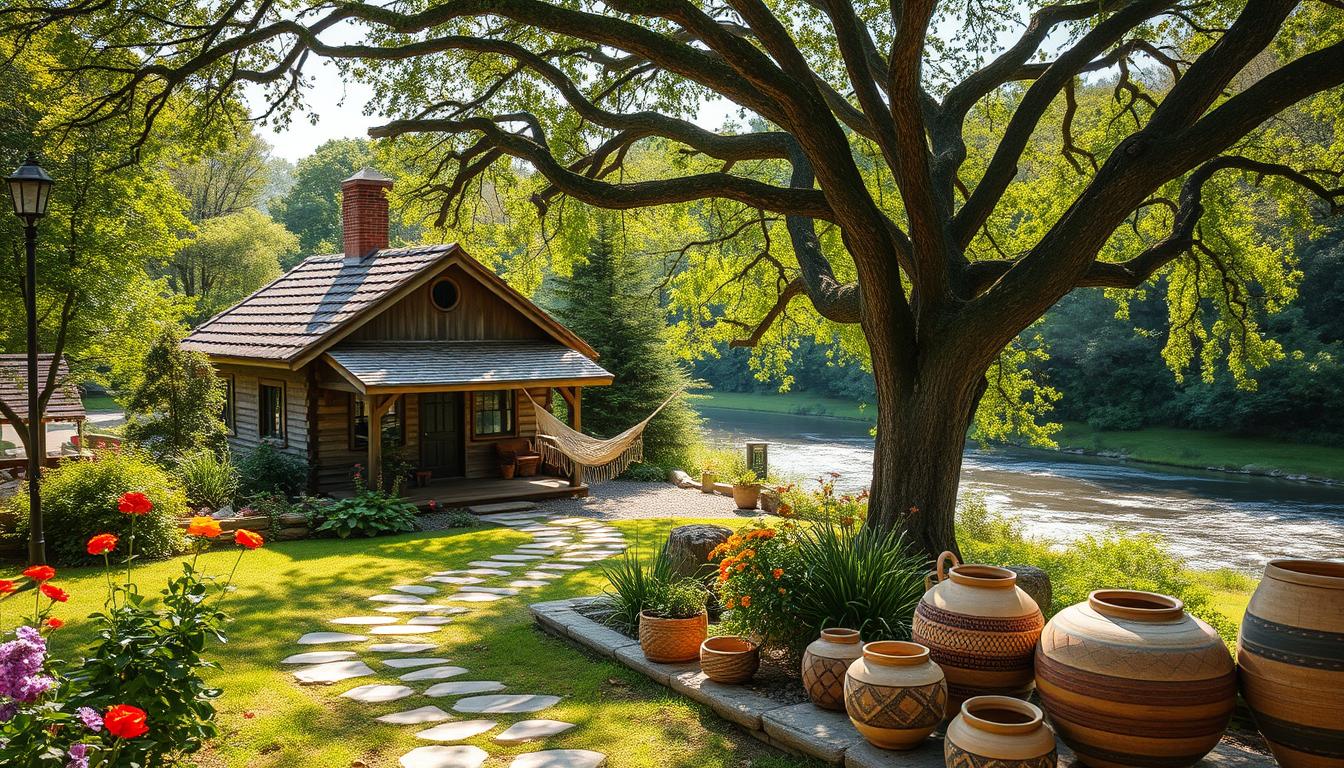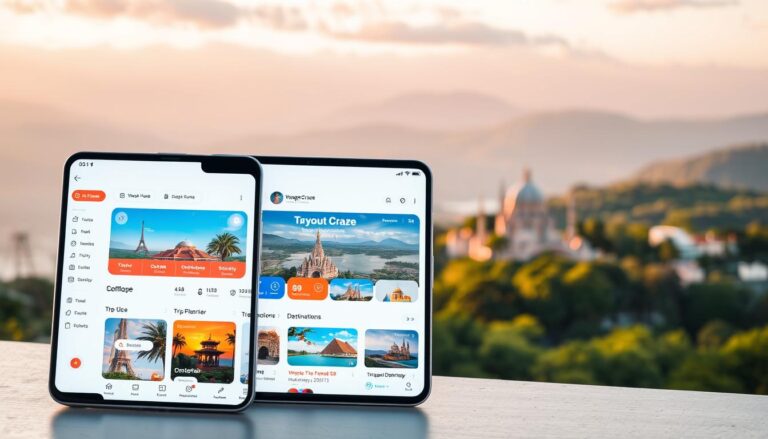In today’s fast world, it’s easy to get lost in the daily rush. Social media, constant alerts, and endless tasks make us feel overwhelmed. That’s why 30% of U.S. adults feel like they can’t keep up. Slow Living offers a way to live more intentionally and at a slower pace.
By adopting Slow Living, we can live more mindfully and find joy in the simple things. We focus on what’s important and cut down on stress and worry.
Slow Living is key to a happier life. It’s shown to boost life satisfaction by 40%. By slowing down, we can lower our stress, strengthen our bonds with others, and appreciate the little moments more.
Key Takeaways
- Slow Living is an approach to life that emphasizes intentional living and a slower pace.
- 30% of adults in the U.S. report feeling overwhelmed by the pace of modern life.
- Slow Living can increase overall life satisfaction by 40%.
- Practicing mindfulness for just 10 minutes daily can enhance focus and reduce mind-wandering by approximately 70%.
- 60% of participants in mindfulness programs noted significant improvements in their ability to manage stress and emotional well-being.
- Slow Living can help individuals cultivate a more mindful and fulfilling life, prioritizing what truly matters and reducing stress and anxiety.
- By embracing Slow Living, individuals can improve their relationships and deepen their connections with others.
Understanding Slow Living
Slow living is a way of life that focuses on mindfulness and simplicity. It lets people fully enjoy their surroundings. It’s not about moving slowly, but about being careful with our time. We focus on the quality, not the quantity.
The slow movement started in Italy in the 1980s. It has grown into a wider life philosophy. At its heart, slow living is about being aware and appreciative of the moment. It’s about letting go of the need for constant speed and productivity.
As an expert says, “Slow living isn’t a step back from today’s fast pace. It’s a way to fully engage with it, calmly and mindfully.” This way of living can greatly improve our well-being. It can reduce stress and anxiety and make us feel more connected and fulfilled.
- Prioritizing quality over quantity in our daily lives
- Cultivating mindfulness and presence in our interactions and activities
- Embracing simplicity and letting go of unnecessary complexity
By following these principles, we can live a more genuine and fulfilling life. It’s a life filled with mindfulness, simplicity, and a stronger connection to ourselves and the world.
Benefits of Embracing Slow Living
Slow living offers many benefits, from better mental health to stronger relationships. It helps us say no to being always busy. Instead, we focus on conscious living. This way, we feel less stressed, more fulfilled, and connect deeper with others.
Some key benefits of slow living are:
- Improved mental health, with reported decreases in anxiety and stress levels
- Increased overall life satisfaction, with 35% of respondents practicing mindfulness techniques experiencing enhanced satisfaction
- Enhanced relationships, with 55% of individuals engaging in deliberate and intentional living experiencing a marked improvement in their relationships with others
Also, slow movement helps us feel more connected to our community. 70% of people who value meaningful connections feel more at home and part of a community. By living slowly, we can make our lives better in many ways.

| Benefit | Percentage of Respondents |
|---|---|
| Reduced stress levels | 60% |
| Improved overall life satisfaction | 35% |
| Enhanced relationships | 55% |
Practical Steps to Start Slow Living
Starting slow living is a journey that needs intentional living and a desire to simplify life. It starts with small steps that can lead to big changes over time. First, declutter both physical and mental spaces to focus on what’s important.
By setting priorities based on personal values, you can change your mindset and habits. It’s also key to schedule downtime for rest and reflection. This helps create a more balanced and fulfilling life.
- Start small by choosing one area of life to slow down and gradually expand these changes.
- Practice mindfulness and gratitude daily to increase positivity and contentment.
- Establish boundaries to concentrate on what truly matters and avoid overcommitment.
By taking these practical steps, you can start your slow living journey. You’ll embrace intentional living and simplicity, leading to a more fulfilling life.
| Practical Steps | Benefits |
|---|---|
| Decluttering physical and mental spaces | Clearer focus, reduced stress |
| Prioritizing tasks and goals | Increased productivity, better time management |
| Scheduling downtime | Improved rest, reflection, and overall well-being |
Mindful Consumption
Living a sustainable lifestyle means making smart choices every day. This includes how we buy and use products. By living more consciously, we can cut down on waste and support fair brands. This helps make the world a better place for the future.
Choosing quality over quantity is key in mindful consumption. It’s about picking items that last longer, not just cheap ones. This choice helps the planet and supports companies that care about the environment. For instance, buying local, seasonal food cuts down on waste and supports local farmers.
Here are some ways to live more mindfully:
- Opt for second-hand or vintage items instead of new ones
- Look for products with little packaging or made from recycled materials
- Support companies that focus on being green and fair

By adopting these habits, we can live more consciously. This helps us all move towards a greener future. As we face big environmental issues, choosing to consume mindfully is crucial.
| Principle | Benefits |
|---|---|
| Choosing quality over quantity | Reduces waste, supports sustainable companies |
| Buying seasonal produce | Promotes sustainable agriculture, reduces food waste |
Creating a Slow Living Ritual
Slow living and intentional living can change our daily lives deeply. By making meaningful rituals and routines, we live more mindfully. For example, doing dishes quietly can become a special moment.
Studies show that starting the day with a mindful routine boosts productivity by up to 30%. Just a few minutes each morning for meditation, deep breathing, or enjoying coffee can make a big difference. Evening reflections also help us relax after a busy day.
Morning Routines for a Peaceful Start
- Start with a 10-minute meditation practice to clear your mind
- Enjoy a cup of coffee or tea in peace, savoring the flavors and aromas
- Take a short walk outside to get some fresh air and sunlight
Evening Reflections for Closure
Evening reflections help us unwind and reflect on the day. It could be journaling, gentle stretches, or a warm bath. These rituals make our lives more intentional and joyful.
| Ritual | Benefits |
|---|---|
| Morning Meditation | Increased productivity, reduced stress |
| Evening Reflections | Improved sleep, increased self-awareness |
Connecting with Nature
Living a simpler life means reconnecting with nature. Spending time outdoors is good for both body and mind. It can lower blood pressure and reduce stress.
Outdoor activities like nature walks help us be more mindful. This can make us appreciate nature more. It also improves our mental health, sometimes by up to 40%.

- Reduced stress levels
- Improved mental well-being
- Increased sense of gratitude
- Enhanced creativity
By living slower and connecting with nature, we can enjoy many benefits. This leads to a more fulfilling and meaningful life.
Reducing Digital Distractions
In today’s world, living consciously and sustainably means being smart about our tech use. Setting limits on technology helps us take back our time and focus. By making tech-free times and places, we make room for deeper connections and activities. This leads to a more balanced and satisfying life.
Here are some stats that show why we need to cut down on digital distractions:
- It takes 23 minutes to get back on track after a distraction.
- 58% of home workers get sidetracked by social media.
- 90% of remote workers face many digital distractions, getting about 14 interruptions daily.
Using digital detox days and setting screen limits can help us fight distractions and boost productivity. By being more aware of how we use technology, we can live more consciously. This supports a more sustainable lifestyle.
Building a Supportive Community
Living intentionally and embracing the slow movement can change your life. Sharing this journey with others makes it even more powerful. A supportive community is key for those wanting to live life at a slower pace. It offers a network of people who share your values and goals.
Studies show that being part of a community boosts our well-being. 74% of people feel happier and more fulfilled when they connect with others. For those into intentional living and the slow movement, community provides support, inspiration, and a sense of belonging.
Here are some ways to create a supportive community:
- Join local groups or online forums focused on slow living and intentional living
- Participate in community activities, such as volunteer work or group meditation
- Engage in homesteading activities, like gardening or food preservation, with others
Building a supportive community helps deepen your practice of intentional living and the slow movement. It leads to a more fulfilling and meaningful life.
| Community Activity | Benefits |
|---|---|
| Group Meditation | Reduced stress, increased mindfulness |
| Volunteer Work | Increased sense of purpose, social connections |
| Homesteading Activities | Practical skills, sense of community |
The Role of Hobbies in Slow Living
Living simply and mindfully can be done through hobbies. These activities bring joy and make life more meaningful. They help us find old passions and try new ones.
Studies show hobbies are good for our minds and bodies. They can lower stress by 34%. Also, 60% of people feel more fulfilled when they have hobbies. Gardening, knitting, and cooking are popular hobbies that have grown a lot.
Slow living is about being simple and mindful. Hobbies like journaling, birdwatching, or sewing help us live in the moment. They let us express ourselves and feel calm.
- Reduced stress levels
- Improved mental health
- Increased sense of fulfillment
- Greater connection to community
| Hobby | Benefit |
|---|---|
| Gardening | Reduced stress levels, improved mental health |
| Cooking | Increased sense of fulfillment, improved physical health |
| Journaling | Improved mental health, increased self-awareness |
Slow Food and Its Importance
Living a sustainable lifestyle is closely tied to slow food. It focuses on the quality and health benefits of our meals. This way of eating is a big part of slow living. It helps us connect with our food and the effort it takes to make it.
The farm-to-table movement is a big part of slow food. It encourages using local, seasonal ingredients. This helps local businesses and cuts down on food‘s environmental impact. Carlo Petrini, the Slow Food founder, said,
“The slower we eat, the more we can savor the flavors and the company of those we are with.”
Slow food has many benefits, including:
- Higher nutrient density in locally sourced, seasonal produce
- Reduced greenhouse gas emissions from food production and transportation
- Support for local economies and biodiversity
By choosing slow food, we help the planet and our health. It makes us appreciate our food more. This aligns with the values of slow living.
Maintaining Slow Living in Everyday Life
Starting a slow living journey means making daily choices with care. It’s about living with purpose and being mindful. This can help lower stress, which affects over 75% of people today.
Adopting a slow movement lifestyle means valuing quality over quantity. It’s about choosing meaningful experiences and being mindful of what we consume. Studies show that taking time to relax can increase creativity by up to 50%.
Long-Term Benefits of a Slower Pace
Living intentionally can bring lasting changes to your life. It helps you focus on what’s truly important, leading to more happiness. The slow food movement shows how valuing quality can improve both our lives and the environment.







